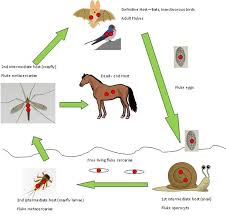Potomac Horse Fever (PHF): Neorickettsia (Ehrlichia) risticii
by Robert N. Oglesby DVM
Introduction
Introduction
»
Transmission
»
History and Signalment
»
Symptoms
»
A Diagnostic Challenge and Some Unusual Cases
»
Treatment
»
Prognosis
»
Vaccination
»
More Info & Discussions
In 1979 a disease characterized by fever, diarrhea, and often laminitis that occured during later summer and fall months was seen in the Potomac river basin of the Atlantic coastal region of the US.
Labeled "Potomac Horse Fever" (PHF) it resembled other causes of large bowel diarrhea, but the inability to isolate known causes started veterinarians looking harder. A bacteria-like organism was isolated from the infected horses blood and cells of the large colon and determined to be the ricketssial organism Neorickettsia (Ehrlichia) risticii. This organism turned out to be the cause of the disease. Since that time the organism has been identified serologically in most states of the US, most of the Canadian provinces, and many countries including France, Italy, Venezuela, Brazil, Uganda, India, and Australia.
This article discusses transmission, clinical signs, diagnosis, treatment and prognosis of PHF. Also vaccination and other prevention is discussed.
Transmission
Introduction
»
Transmission
»
History and Signalment
»
Symptoms
»
A Diagnostic Challenge and Some Unusual Cases
»
Treatment
»
Prognosis
»
Vaccination
»
More Info & Discussions
It was quickly noted that infection occurred during the later warm months of the year and around bodies of water, usually rivers, leading to the suspicion of aquatic insects playing a role in the transmission. Dr Madigan in California, his associates, and others around the country have fleshed out the transmission of this organism to horses.
N. risticii is known to occur in the environment within the microscopic larval forms of trematodes. Trematodes are flukes, a type of flat worm. The larval flatworms use freshwater snails as a intermediate host then leave the snail to infect a second intermediate host the larval forms of various aquatic insects including larval and nymph stages of caddisflies. These larval aquatic insects then molt to their adult forms and fly away carrying the trematode that is infected with the PHF organism.
When these caddisflies die and fall into the pastures and water tubs they may be incidentally ingested by horses. that then become infected with PHF. In early 2002, a group of researchers from Ohio State, showed that horses, upon ingestion of infected adult caddisflies (an aquatic insect), developed clinical signs of Potomac horse fever, and Neorickettsiaa risticii was isolated from the blood.
Currently only a few types of caddisflies have been identified, but it is believed, a large number of these type insects can carry the PHF organism. To complete the life cycle of the trematode and the PHF organism it is carrying it is currently thought that birds and bats ingest the infected caddisflies and release infected trematodes in their feces. These inturn infect snails which completes the life cycle.
It remains unknown if horses can be become infected through ingestion of the infected trematodes or snails. Experimentally healthy horses have been infected by feeding on the feces of infected horses. This does not appear to be a common source of infection naturally.
History and Signalment
Introduction
»
Transmission
»
History and Signalment
»
Symptoms
»
A Diagnostic Challenge and Some Unusual Cases
»
Treatment
»
Prognosis
»
Vaccination
»
More Info & Discussions
To read more on this topic become a member of
Horseadvice.com! Your membership gets you instant access to this and over 600 equine articles on our site. Other benefits of your membership include participation in our discussion boards and access to our one button PubMed search tool for each topic.
Horseadvice.com educates you to be a more knowledgeable horse owner which leads to healthier horses and save you money, we guarantee it. Come Join Us!
